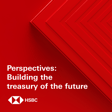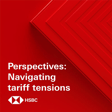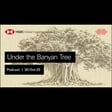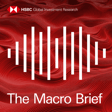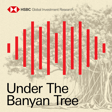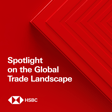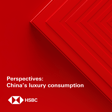Become a Creator today!Start creating today - Share your story with the world!
Start for free
00:00:00
00:00:01

Under the Banyan Tree - Cooperation states: Singapore and Malaysia
Fred Neumann sits down with ASEAN Economist Yun Liu to take the pulse on two key Southeast Asian economies and how they're working together to support future growth. Disclaimer: https://www.research.hsbc.com/R/101/VpnTWF6. Stay connected and access free to view reports and videos from HSBC Global Research follow us on LinkedIn https://www.linkedin.com/feed/hashtag/hsbcresearch/ or click here: https://www.gbm.hsbc.com/insights/global-research.
Hosted on Acast. See acast.com/privacy for more information.
Transcript
Introduction to HSBC Global Viewpoint Podcast
00:00:02
Speaker
Welcome to HSBC Global Viewpoint, the podcast series that brings together business leaders and industry experts to explore the latest global insights, trends, and opportunities.
00:00:13
Speaker
Make sure you're subscribed to stay up to date with new episodes.
00:00:16
Speaker
Thanks for listening.
00:00:17
Speaker
And now onto today's show.
00:00:24
Speaker
This is a podcast from HSBC Global Research, available on Apple Podcasts and Spotify.
00:00:29
Speaker
However you're listening, analyst notifications, disclosures and disclaimers must be viewed on the link attached to your media player.
Focus on Asian Markets with Fred Newman
00:00:45
Speaker
Hello and welcome to Under Banyan Tree, where we put Asian markets and economics in context.
00:00:50
Speaker
I'm Fred Newman, Chief Asia Economist here at HSBC.
Malaysia and Singapore Economic Growth Discussion
00:00:53
Speaker
Today we're putting a spotlight on Southeast Asian neighbors Malaysia and Singapore.
00:00:58
Speaker
Growth is bouncing back in both economies and cooperation is high on the agenda.
00:01:03
Speaker
Southeast Asia Economist Yuen Liu joins me in a Hong Kong studio.
00:01:06
Speaker
Let's get the conversation started Under the Banyan Tree.
00:01:15
Speaker
A few stats to set the scene before we kick off.
00:01:18
Speaker
Malaysia's economy is roaring, up more than 5% year-over-year in the first half of 2024.
00:01:23
Speaker
It's been a broad recovery led by electronics, trade and manufacturing.
00:01:28
Speaker
And that's also been a key theme for Singapore, where actually growth in the third quarter of this year was above 4% year-over-year, a very respectable rate of growth for the city-state.
00:01:40
Speaker
Both economies are now looking to expand further with the creation of a special economic zone.
00:01:44
Speaker
Let's bring in Yun Liu for more on this relationship.
00:01:48
Speaker
Yun, welcome to the podcast.
00:01:49
Speaker
Thank you for having me, Brad.
00:01:51
Speaker
So, Yun, you cover a number of the Southeast Asian economies, but we really want to focus on Singapore and Malaysia today, the growing ties, of course, and growing prospects for economic growth.
00:02:04
Speaker
But before we talk about the interrelationship between Singapore and Malaysia, let's
00:02:08
Speaker
Let's just take stock of where we are in terms of the post-COVID recovery in both of these economies.
00:02:14
Speaker
How will you characterize, for example, Singapore's recovery through COVID-19 and after that?
Singapore's Economic Diversification
00:02:20
Speaker
Well, actually, we saw quite a lot of good momentum just post-COVID in 2022.
00:02:24
Speaker
That was the first year when most of Southeast Asian countries started to open up.
00:02:31
Speaker
So 2022 growth was very nice to everyone.
00:02:33
Speaker
But in 2023, we saw this severe downturn in the global trade cycle, which dragged growth quite significantly in a lot of the exploratory economies.
00:02:42
Speaker
So Singapore included, Malaysia included as well.
00:02:46
Speaker
But this year, for the past six months, we really see those two economies roaring back, riding on the back of this trade upturn again.
00:02:55
Speaker
So focusing on Singapore, we had growth above 4% actually in the third quarter.
00:03:01
Speaker
That is for an economy of Singapore's development level, a very, very strong number indeed.
00:03:08
Speaker
What's been driving that growth?
00:03:10
Speaker
Yeah, so for a DM economy to grow above 4% on a year-year basis is quite decent, but it's almost entirely driven by the manufacturing revival.
00:03:20
Speaker
I mean, really, we saw two quarters of outright declines in manufacturing activity.
00:03:25
Speaker
And finally, Singapore's manufacturing sector swung back to decent growth, and we're talking about almost 10% in just one quarter.
00:03:33
Speaker
10% growth for manufacturing.
00:03:35
Speaker
Now that's a good reminder because it suggests that when you think about Singapore, you think about services, financial services, very big financial services, of course, but tourism is very big, retail is very big, medical services very big.
00:03:48
Speaker
But what you're saying is that actually manufacturing is still an important part of the Singaporean economy.
00:03:54
Speaker
Exactly, yeah.
00:03:55
Speaker
So for Singapore, actually, manufacturing accounts for over 20% of its GDP.
00:04:01
Speaker
And as you said, you know, it's actually a well-diversified economy, not only within manufacturing, but also within services as well.
00:04:08
Speaker
So I think for the semiconductor story, Singapore has been slightly lagging behind peers like, you know, Taiwan or Korea, but now it's really finally picking up.
00:04:18
Speaker
So you're saying semiconductors are part of the Singaporean manufacturing story.
00:04:22
Speaker
What other sectors in terms of manufacturing does Singapore still have a presence in?
00:04:27
Speaker
Because it's such a small economy and it's such a developed city-state.
00:04:30
Speaker
And what other manufacturing actually still happens in Singapore?
00:04:34
Speaker
It is actually quite a well-diversified picture.
00:04:36
Speaker
We're talking about pharmaceutical manufacturing.
00:04:39
Speaker
We're talking about precision engineering.
00:04:41
Speaker
So it's a lot of those capital intensive, you know, at the very much high end part of manufacturing.
00:04:47
Speaker
It doesn't really consume too much land, but a lot of it, it's high tech.
00:04:52
Speaker
Now, last question on Singapore.
Regional Collaboration between Singapore and Malaysia
00:04:55
Speaker
It's a very geographically very small economy, and there's probably a risk that we're hitting growth constraints, isn't there?
00:05:02
Speaker
I mean, is there, you know, there's a limited amount of people in Singapore, and of course, there have been
00:05:09
Speaker
Also trying to regulate a little bit the immigration inflow because it needs to be sustainable.
00:05:15
Speaker
We've seen obviously lack of land, there's water resources.
00:05:20
Speaker
How much is Singapore bumping against its natural constraints there?
00:05:25
Speaker
Well, I mean, there are definitely that concerns, but Singapore has been trying to cooperate with its regional neighbors to mitigate the efforts.
00:05:34
Speaker
Like, you know, in terms of, say, for example, the data centers, actually Singapore has a lot of data centers.
00:05:39
Speaker
But given that constraint, now Singapore is actually looking just across its causeway to its neighbor for more cooperation.
00:05:46
Speaker
And just now, you know, we've been talking about this manufacturing story.
00:05:49
Speaker
So a large part of it actually doesn't consume that much land and labor.
00:05:53
Speaker
It's very capital intensive.
00:05:54
Speaker
So it's, you know, the value add of the sector.
00:05:58
Speaker
So very efficient use of land.
00:06:00
Speaker
And of course, efficiency is sort of a byword for Singapore's economy.
00:06:04
Speaker
That's been the watchword for the government to drive efficiency.
00:06:08
Speaker
But you hint at really the connectivity to other economies in the region, which is very important.
00:06:14
Speaker
Singapore being one of the most connected economies, of course, in the world.
00:06:18
Speaker
But before we talk about the connectivity specifically, let's talk about Malaysia.
Tourism and Manufacturing in Malaysia
00:06:23
Speaker
How has the Malaysian economy done since COVID-19 and how has it done over the last few quarters?
00:06:28
Speaker
Yeah, so for Malaysia, I mean, 2022, Malaysia's economy was actually the best performer in ASEAN.
00:06:35
Speaker
But in 2023, it decelerated quite hugely, you know, precisely because of that drag in the trade cycle.
00:06:41
Speaker
But we are finally seeing Malaysia's economy roaring back again now for the first half of the year.
00:06:48
Speaker
And we expect that momentum to continue.
00:06:50
Speaker
So the trade part, I think, is very much important for Malaysia, but there's actually quite a lot of good momentum in the services part, in private consumption.
00:06:58
Speaker
Tourism-related stuff is actually a bright spot in Malaysia's economy.
00:07:03
Speaker
So it's also a well-diversified economy.
00:07:06
Speaker
Yeah, we don't tend to think of Malaysia as a tourism destination, but tourism is a huge part of the Malaysian economy.
00:07:13
Speaker
When people think about tourism, they think about Thailand, for example, the Bali beaches.
00:07:17
Speaker
But Malaysia, a big tourist destination, and they now have
00:07:22
Speaker
Visa-free access, I think, for Chinese tourists, which is really driving arrivals.
00:07:26
Speaker
That's right.
00:07:26
Speaker
I think the visa-free program is very much the game changer this year.
00:07:31
Speaker
So if we look at the recovery rate of mainland Chinese tourists back in ASEAN, actually Malaysia is number one within ASEAN.
00:07:39
Speaker
And one visa waiver, I think it very much changes people's mentality.
00:07:44
Speaker
It makes the Chinese tourists feel comfortable.
00:07:47
Speaker
easier and closer to come to Malaysia.
00:07:49
Speaker
And the other one, I think Malaysia also provides a lot of its niche products.
00:07:54
Speaker
And here we're talking about durian.
00:07:57
Speaker
I was just waiting to when you bring in the durian story.
00:08:01
Speaker
So...
00:08:02
Speaker
You're saying Chinese are flocking to Malaysia, not just because it's visa-free, but also because it has allegedly the most delicious durian in Southeast Asia?
00:08:10
Speaker
Exactly, exactly.
00:08:11
Speaker
I have to confess that I am a big fan of Malaysia's Musa and King durian.
00:08:16
Speaker
But obviously, there are a lot more varieties than that.
00:08:20
Speaker
But I think it's something that Chinese consumers are looking out for.
00:08:26
Speaker
Now, before you write in, dear listeners, we're not taking a view of which durian is the most delicious.
00:08:32
Speaker
I know there are intense national rivalries in terms of who breeds the best durian.
00:08:36
Speaker
You know, we're just saying they all are good durians and Malaysia is among the good ones.
00:08:41
Speaker
But maybe this is a good time to take a quick break.
00:08:44
Speaker
And when we come back, let's hone in a little bit on the manufacturing recovery story in Malaysia and look at how that really ties into Durian.
00:08:53
Speaker
Singapore, and how the two are starting to cooperate more.
00:09:06
Speaker
So, before the break, we talked about, you know, Malaysian economy doing quite well, and we hone a little bit on services, tourism, for example.
00:09:13
Speaker
But, of course, manufacturing is a big part of the Malaysian story as well.
00:09:18
Speaker
What are some of the sectors there that you see continuing to do well, and what's driving that?
00:09:23
Speaker
I think the electronics sector definitely is one of the bright spots here.
00:09:28
Speaker
And actually, not a lot of people know that Malaysia holds quite a significant part in this global tech supply chain.
00:09:35
Speaker
Well, I mean, it's still relatively labor intensive.
00:09:38
Speaker
But if you look at its global share, it holds about the world 13% of what we call ATP, so assembly testing and packaging.
00:09:47
Speaker
You know, in terms of the tech recovery, it's still lagging behind everyone else because it doesn't have direct exposure to the AI-powered chips.
00:09:54
Speaker
But as demand for global consumer electronics are picking up gradually, and we expect that trend to benefit Malaysia in the second half of this year.
00:10:03
Speaker
So semiconductors, you said ATP, which is assembly testing and packaging, which is an important part of the semiconductor supply chain.
00:10:11
Speaker
So some of the semiconductors are being produced in Korea or Taiwan or even Singapore brought across the border for ATP types of activity, which is actually very important.
00:10:21
Speaker
And Malaysia has a good footprint in that.
00:10:24
Speaker
But outside of semiconductors, what are some of the other manufacturing sectors that are still doing well in Malaysia?
00:10:31
Speaker
Or is it mostly electronics?
00:10:32
Speaker
I think for now, this story, it's still very much limited to the electronic story.
00:10:37
Speaker
The other thing that Malaysia is known for is being a net commodity exporter.
00:10:43
Speaker
But, you know, in today's world, it probably doesn't really help it as much as, say, back in 2022.
00:10:49
Speaker
But what I see, I mean, especially, you know, in terms of all these FDI relocations or FDI commitments coming to Malaysia, data center is one, you know, very much a rising topic or quite a hot topic in recent months.
00:11:02
Speaker
And the other one is the green transition, green sectors here.
00:11:06
Speaker
And a lot of the FDI actually comes from China.
00:11:10
Speaker
That's interesting.
00:11:10
Speaker
So green technology, of course, even though Malaysia is traditionally an oil and gas exporter, but is now starting to pivot into green technology for assembly and production, but also in terms of its own energy transition, I think Malaysia has developed
00:11:28
Speaker
ambitious plants here.
00:11:30
Speaker
And part of that is related to the other thing you mentioned, which is data centers, which are very, very power hungry.
00:11:36
Speaker
So Malaysia is facing a bit of a requirement to invest heavily in
Special Economic Zone and Economic Integration
00:11:43
Speaker
electricity.
00:11:43
Speaker
Talk to us about the data center business and what it means for Malaysia.
00:11:48
Speaker
Yeah, I think, I mean, for Malaysia, you know, in terms of the semiconductor part, we're mainly talking about Penang, which is in the north.
00:11:55
Speaker
But then when it comes to data centers, we're mainly talking about Jehovah Ru, which is right next to Singapore.
00:12:01
Speaker
And for now, we see quite a lot of commitments from the big giants.
00:12:06
Speaker
We're talking in the video, talking about Google and Amazon.
00:12:10
Speaker
So I think the idea here is really, you know, to set up that Johor, Singapore, or SEZ, Special Economic Zone.
00:12:17
Speaker
And, you know, Singapore has the technology, but it lacks in its natural resources.
00:12:23
Speaker
And that's exactly what Malaysia has.
00:12:25
Speaker
And in particular, Johor holds a very significant and strategic position to that.
00:12:30
Speaker
So in terms of abundance of land here, in terms of power, in terms of electricity, that's all very significant for tech giants to move.
00:12:39
Speaker
So this is a great example then of the complementarity of Malaysia and Singapore's economy where we mentioned in the first segment that Singapore has a lack of land, obviously it's a geographically fairly small area.
00:12:52
Speaker
Data centers need land, they need energy, they need water.
00:12:56
Speaker
and that is in relatively greater abundance in Malaysia.
00:13:00
Speaker
And so we're seeing really this data intensive industry of Singapore basically relying on southern Malaysia for that data center provision.
00:13:10
Speaker
But you mentioned the word there, special economic zone.
00:13:14
Speaker
Tell us more about this.
00:13:15
Speaker
Is this an economic zone between Singapore and Malaysia?
00:13:19
Speaker
Where are we at in terms of negotiations and what does this encompass?
00:13:24
Speaker
Well, I mean, it's called the Zhehou Singapore SEZ Special Economic Zone.
00:13:28
Speaker
So you can sort of think about it as the same idea as, you know, how Hong Kong and Shenzhen, sort of greater Bay Area, that kind of concept.
00:13:37
Speaker
And the negotiations are still ongoing.
00:13:39
Speaker
We'd probably expect, you know, to hear some news by the end of this year.
00:13:43
Speaker
But I think the concept here is really, you know, the two economies are very much complementary to each other.
00:13:49
Speaker
So it's like, you know,
00:13:51
Speaker
each of them doing what they're best and trying to capitalize or set up an ecosystem around that area.
00:13:58
Speaker
So we're witnessing in real time really here the emergence of a regional economy, sort of more integrated.
00:14:07
Speaker
Presumably, there's a lot in there for Singapore because it's hitting a little bit its natural growth boundaries in certain sectors that allow Singaporean economy to expand, to use, to outsource more to Malaysia and help it to grow.
00:14:24
Speaker
What's in there for Malaysia?
00:14:26
Speaker
I think for Malaysia, I mean, if, you know, the SEZ can materialize anytime soon, it very much serves as a gateway to ASEAN.
00:14:36
Speaker
And not only for, you know, Singapore, say, FDI coming to Malaysia, but also to attract more FDI from outside of the region.
00:14:44
Speaker
And then when they decide where to invest, you know, they see the potential in that SEZ.
00:14:49
Speaker
So,
00:14:50
Speaker
I think that's easy if we play the cards right and if implementation comes timely, then it very much increases the attractiveness of Malaysia as an FDI designation here.
00:15:01
Speaker
So that's very promising.
00:15:03
Speaker
I think a reminder that when we think about Asia, we think about the big economies of India emerging.
00:15:10
Speaker
We think about, of course, mainland China is still there.
00:15:12
Speaker
But here there is these micro stories, Singapore and Johor, which is across the border.
00:15:18
Speaker
That's a huge economic engine itself.
00:15:20
Speaker
And we're seeing in real time really that integration happening.
00:15:23
Speaker
That's all a positive story.
Risks from Global Trade Tensions
00:15:25
Speaker
Are you concerned?
00:15:25
Speaker
Are there some concerns we should be aware of in the near term?
00:15:29
Speaker
I mean, both are very highly trade-dependent economies.
00:15:33
Speaker
So, yes, even if structurally this is positive, are you worried about a bit of dark clouds on the horizon a little bit when it comes to trade?
00:15:41
Speaker
Yes, I do, actually, because, you know, when we talk about the trade tensions, the two biggest beneficiaries here in ASEAN, one is Vietnam and the other is in Malaysia.
00:15:49
Speaker
So by the same token, if there's any material change to that trade policy, not only on China, but also on ASEAN in particular, you know, after the U.S. election, I think it very much poses some uncertainty there.
00:16:06
Speaker
I mean, it's pretty much the same coin, but both sides.
00:16:09
Speaker
There are upside, but then at the same time, there are also a lot of downside rates as well.
00:16:14
Speaker
Yeah, of course.
00:16:14
Speaker
You know, an economy that is built on, you know, more trade and more investment, cross-border investment, which these two economies really are.
00:16:22
Speaker
They're sort of the, I think, this poster child, if you will, for globally open economies.
00:16:28
Speaker
Of course, anything that upsets, you know, the past was great at global integration is a bit of a worry.
00:16:34
Speaker
But it's interesting that they're responding also with their own structural reforms domestically.
00:16:39
Speaker
Exactly.
00:16:40
Speaker
And integration to unleash some of those efficiency gains to stay in the game.
00:16:43
Speaker
Yes, that's right.
00:16:45
Speaker
Well, thank you very much, Jun.
00:16:47
Speaker
I think we'll have you back to see how this special economic zone then comes into being and what the effect will be.
00:16:53
Speaker
And we'll certainly keep a close eye on the Singaporean and Malaysian economies here under the Banyan tree.
00:16:59
Speaker
So thank you, Jun.
00:17:00
Speaker
Thank you for having me.
Conclusion and Call to Action
00:17:04
Speaker
And that's a wrap for another week here under the Banyan Tree.
00:17:06
Speaker
Many thanks for joining us.
00:17:08
Speaker
And a quick word to those of you who are HSBC clients.
00:17:11
Speaker
HSBC Global Research is taking part this year in the Extel Asia Survey for 2025.
00:17:18
Speaker
So please consider voting in the survey, which actually runs from the 12th of November to the 6th of December.
00:17:24
Speaker
For now, take care and talk to you again very soon.
00:17:52
Speaker
Thank you for joining us at HSBC Global Viewpoint.
00:17:56
Speaker
We hope you enjoyed the discussion.
00:17:58
Speaker
Make sure you're subscribed to stay up to date with new episodes.
